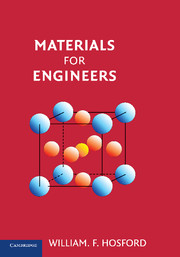Book contents
- Frontmatter
- Contents
- Preface
- 1 Introduction
- 2 Phases
- 3 Diffusion
- 4 Mechanical Behavior
- 5 Mechanical Failure
- 6 Annealing
- 7 Iron and Steel
- 8 Nonferrous Metals
- 9 Casting and Welding
- 10 Solid Shaping
- 11 Polymers
- 12 Polymer Processing
- 13 Glasses
- 14 Crystalline Ceramics
- 15 Powder Processing
- 16 Pottery and Concrete
- 17 Composites
- 18 Carbon
- 19 Fibers, Foams, and Porous Materials
- 20 Electrical Properties
- 21 Optical and Thermal Properties
- 22 Magnetic Materials
- 23 Corrosion
- 24 Modern Manufacturing Techniques, Surface Treatments, and Recycling
- APPENDIX 1 Wood
- APPENDIX 2 Miller Indices for Planes and Directions
- APPENDIX 3 X-ray Diffraction
- APPENDIX 4 Surfaces
- APPENDIX 5 Dislocations
- APPENDIX 6 Avrami Kinetics
- APPENDIX 7 Organic Chemistry
- APPENDIX 8 Average Molecular Weight
- APPENDIX 9 Bond Geometry in Compounds
- APPENDIX 10 Weibull Analysis
- Index
- Conversions
23 - Corrosion
Published online by Cambridge University Press: 05 June 2012
- Frontmatter
- Contents
- Preface
- 1 Introduction
- 2 Phases
- 3 Diffusion
- 4 Mechanical Behavior
- 5 Mechanical Failure
- 6 Annealing
- 7 Iron and Steel
- 8 Nonferrous Metals
- 9 Casting and Welding
- 10 Solid Shaping
- 11 Polymers
- 12 Polymer Processing
- 13 Glasses
- 14 Crystalline Ceramics
- 15 Powder Processing
- 16 Pottery and Concrete
- 17 Composites
- 18 Carbon
- 19 Fibers, Foams, and Porous Materials
- 20 Electrical Properties
- 21 Optical and Thermal Properties
- 22 Magnetic Materials
- 23 Corrosion
- 24 Modern Manufacturing Techniques, Surface Treatments, and Recycling
- APPENDIX 1 Wood
- APPENDIX 2 Miller Indices for Planes and Directions
- APPENDIX 3 X-ray Diffraction
- APPENDIX 4 Surfaces
- APPENDIX 5 Dislocations
- APPENDIX 6 Avrami Kinetics
- APPENDIX 7 Organic Chemistry
- APPENDIX 8 Average Molecular Weight
- APPENDIX 9 Bond Geometry in Compounds
- APPENDIX 10 Weibull Analysis
- Index
- Conversions
Summary
Corrosion of metals can be classified as either corrosion in aqueous solutions or as direct oxidation at high temperatures. Both are electrochemical in nature.
Aqueous Corrosion
An aqueous corrosion cell consists of an anode where metal ions go into solution and electrons are produced, a cathode where electrons are consumed, an aqueous solution between the anode and cathode, and an external electrical connection between the anode and cathode (Figure 23.1). The anode reaction can be written M → Mn+ + ne−, where M stands for a metal. There are several possible cathode reactions:
Mn+ + ne− → M (This can occur only if there is a high concentration of Mn+ ions in solution.)
2H+ + 2e− → H2 (This can occur only in an acid solution.)
O2 + 2H2O + 4e− → 4(OH)− (This is the most common cathode reaction. Note that it requires dissolved O2.)
O2+ 4H+ + 4e− → 2H2O (This occurs in acidic solutions and there must be O2 in an acid solution.)
The anode and cathode reactions must occur at the same rate. The corrosion rate is often limited by the cathode reaction.
The material of the anode is more active (less noble) than the material of the cathode. The electromotive series (Table 23.1) lists the relative activity of common metals in one-molar solutions of their own salts. The most noble (least reactive) metals appear at the top and most reactive at the bottom.
- Type
- Chapter
- Information
- Materials for Engineers , pp. 224 - 230Publisher: Cambridge University PressPrint publication year: 2008



